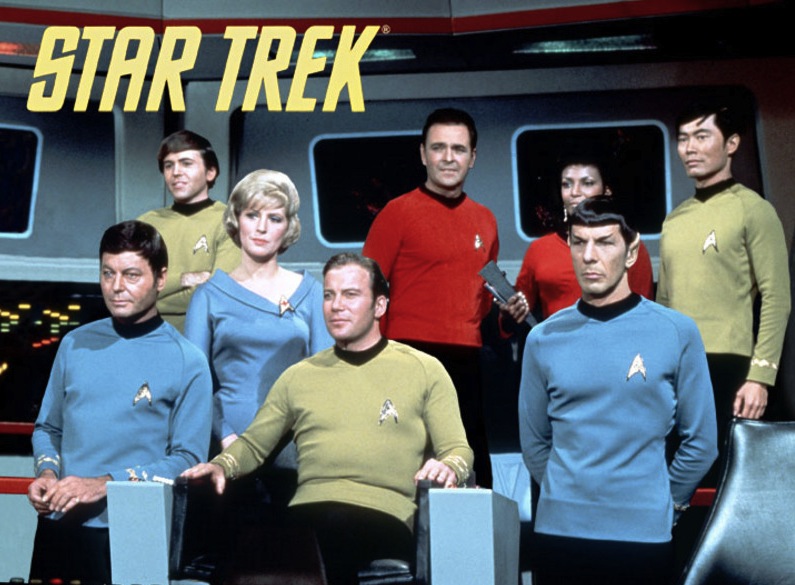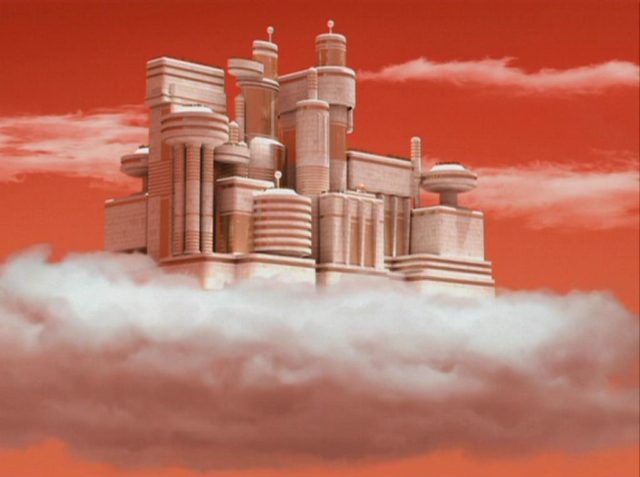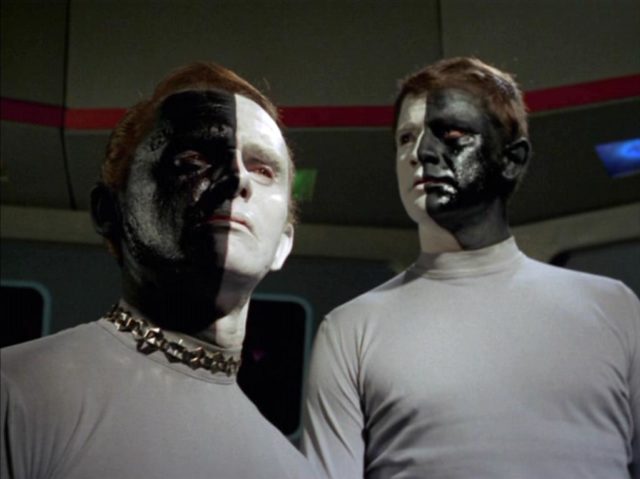Jason M. Barr November 26, 2018
You are a barbarian….Don’t sound so incredulous, captain. We all are. A killer first, a builder second. A hunter, a warrior, and—let’s be honest—a murderer. That is our joint heritage, is it not?
–Anan 7, Leader of the High Council of Eminiar VII, to James T. Kirk, Captain of the U.S.S. Enterprise (TOS:S1:E:23, A Taste of Armageddon)
Here in the 21st century, it is clear that the Homo sapiens of Planet Earth are moving inexorably towards one common global community—a Terran Community—rather than a series of independent nation-states. While we may retain a sense of our individual identities, just below the surface is our umbilical attachment to the great web of technology, trade, and civilization. This web is growing exponentially—intensively and extensively—whether we like or not.
Yet, despite the forces driving humans closer together, they possess an instinct to form social boundaries—to define who is part of the group, and who is an outsider. For example, people are programmed to protest against real or perceived preferential treatment of one person or group over another—perhaps as a self-preservation mechanism.
Today, economic growth and trade have replaced empire and warfare as the main methods of acquiring resources. While we believe we are “buying” ourselves peace through increased consumption and bonding with our computers, we still have no idea where our technology will eventually take us. In the desire for profit, individuals and companies are seeking to demolish the costs of production, communication, and transportation.
The Prospects from Globalization
Thus, global capitalism appears to be moving us toward two possible outcomes. First is that work, as we know it, could be eliminated for a large fraction of the population. But, if the distribution of wealth is highly unequal, the rest of the population will either be unable to find meaningful employment or will be forced to perform drudge work. Second is the instantaneous movement of people, information, and goods and services (either in reality or virtually), which means the near-total elimination of the kinds of boundaries that people seem to require.
The question remains: in what direction do we go? Do humans use their technology to sequester themselves into tribal and economic silos and then turn on each other; or to they use technology to maintain a high quality of life for all? While the events of human history, from the rise of the earliest city-states, to the Roman Empire, to the American Revolution, to Word War II and the Cold War, can offer lessons on how humans have struggled to balance these two opposing forces, we can also learn these lessons from our future, or, rather, from our hypothetical future.
Star Trek: A Simulated Tomorrow
In 1967, the world was introduced to Star Trek. In the original series (TOS), in the 23rd century, the crew of the U.S.S. Enterprise, led by Captain James T. Kirk, traverses the galaxy on a five-year mission of exploration and peace. During the 24th century, in the Next Generation (NG), Captain Jun-Luc Picard commands the Enterprise in its continuing mission to seek out new life and new civilizations. The series has excited the imaginations of countless humans (and humanoids) alike.
The show’s creator, Gene Roddenberry (1921-1991), offered a depiction of the future that was, in many ways, prescient. The series holds up a mirror to ourselves, while also offering a possible mirror for our future selves. It tackles issues of war and peace; identity and the self; automation and artificial intelligence; and how to live in a world where economic walls have been destroyed by technological progress.[1]
Roddenberry’s vision, unlike much of modern science fiction, is relatively upbeat. The word “utopia” is frequently bandied about in reference to the future humans of Planet Earth (a/k/a Terrans). Through the lens of science fiction, the show offers possible models or simulations of what tomorrow could look like, providing lessons on how to balance our opposing impulses of Tribalism and Terranism—or at any rate—possible scenarios if we don’t.

The Star Trek Economy
One of the show’s visionary elements was the economic world it portrays. Since we are likely headed to some version of this future, we can look to the show for guidance. As Manu Saadia highlights in his book Trekonomics, the Star Trek universe is characterized by several key features. First is the elimination, or near elimination, of marginal production costs. Food synthesizers (TOS) and replicators (NG) eliminate material scarcity. Warp drive (at faster than light speed) and transporter beaming mean that people and goods can move anywhere at any time.
In 24th century world of Picard, money is gone. With nearly everything immediately replicatable, there is no need for trade, and, thus, currency melts away.[2] The economics of work—suffering a disutility in exchange for money that allows one to buy goods and services that return a higher utility—is gone. The society offers the freedom to pursue art, science, philosophy, or exploration. Since pining for money is irrelevant, career success is based on reputation, merit, and effort.
Or, as Picard relates to a 21st century Earthling, in First Contact,
The economics of the future is somewhat different….You see, money doesn’t exist in the 24th century. The acquisition of wealth is no longer the driving force in our lives. We work to better ourselves and the rest of humanity.
City in the Clouds
But across the galaxy, the elimination of work may only be for some. Without money, the incentives to perform important but necessary manual labor are gone. This leaves the possibility that it is done through force. The episode, TOS:S3:E21, The Cloud Minders, serves as a warning that a strict two-tiered society can easily evolve. On Ardana, there are those who live the intellectual life high up the floating city of Stratos. On the surface are the oppressed Troglytes, who are forced to do the labor to support the thinkers in the city.
After arriving on the planet, Mr. Spock muses to himself,
This troubled planet is a place of the most violent contrasts. Those who receive the rewards are totally separated from those who shoulder the burdens. It is not a wise leadership. Here on Stratos, everything is incomparably beautiful and pleasant. The High Advisor’s charming daughter Droxine, particularly so. The name Droxine seems appropriate for her. I wonder, can she retain such purity and sweetness of mind and be aware of the life of the people on the surface of the planet? There, the harsh life in the mines is instilling the people with a bitter hatred. The young girl who led the attack against us when we beamed down was filled with the violence of desperation. If the lovely Droxine knew of the young miner’s misery, I wonder how the knowledge would affect her.
The Troglytes resort to violence and terrorism to fight their plight. This further convinces the cloud city residents that Troglytes are inherently inferior, unworthy of the good life in Stratos. In the end, through Kirk’s “cowboy diplomacy” the Troglytes receive help, and the episode ends on an optimistic, if unresolved, note.

Tribalism versus Terransim
On Earth, however, a world of universal peace and enlightenment did not come easily. With its technology, Homo sapiens was forced to confront a choice: it could either destroy itself completely or use its technology to free itself from its baser instincts. The episodes frequently refer to World War III (e.g., TOS:S2:E25, Bread and Circuses; TOS:S1:E21, Space Seed; NG:S1:1E, Encounter at Farpoint) and how the aftermath finally pushed humans to put aside their tribal attitudes and cooperate for the greater good. Admittedly TOS was written during the height of the Cold War, when Mutually Assured Destruction was a looming threat. Though global annihilation from nuclear war is less likely today, the underlying desires and characteristics of humans have not changed all that much.
The series contains a running dialogue with itself about whether humans can suppress their instinctual desires to debase, dehumanize, and attack each other. Captain Kirk takes great delight in reminding those he encounters that humans have achieved peace and harmony by suppressing their killer instincts. The relative peace on Earth and among the United Federation of Planets allows other humanoid species to act as foils—to demonstrate the consequences of not overcoming tribalism. Two episodes offer good examples.
The Last Battlefield
In TOS:S3:E15, Let That Be Your Last Battlefield, the Enterprise captures an unusual looking humanoid, Lokai, who is white on the right half of his body, and black on the left. This “checkered” individual is fleeing his home planet, Cheron, and demands asylum from his pursuer, Commissioner Bele, the Chief Officer of the Commission on Political Traitors. The two individuals appear to be quite similar; yet upon closer inspection, Bele is white on the left and black on the right.
These seemingly minor differences are the seed for deep-seated hatred and segregation. The two are locked in an intergalactic game of cat and mouse. Bele demands Lokai face justice for his crimes as a revolutionary and instigator. Lokai demands freedom for his people. In the end, the antipathy of the two “races” proved too great. Upon returning home, they see that nothing is left; all was destroyed by war. The final scene shows the two running in horror through the empty streets, with absolutely nothing, except their hate.

Sanitized Armageddon
In TOS:S1:E:23, A Taste of Armageddon, the Enterprise arrives (unwelcome) on the planet Eminiar VII, only to discover that the residents are waging a computerized war with rival planet, Vendikar. Rather than fighting with real weapons, the two societies use computers to simulate attacks on each other. But simulated casualties are then translated into real ones. “Killed” residents must report to disintegration machines to be executed. Kirk’s ultimate action is to destroy the computer—let them either face the horrors of a real war directly or find a way to make peace.
The episode highlights how human’s instinct to create enemies—combined with computer technology—can allow for mass genocide with little effects on the quality of daily life. Technology permits both war and Facebook. It also allows the philosopher side of Kirk to rebut Anan 7, to remind him that human instincts can be overcome:
We’re human beings with the blood of a million savage years on our hands! But we can stop it. We can admit that we’re killers . . . but we’re not going to kill today. That’s all it takes! Knowing that we’re not going to kill — today!
To Boldly Go…
While Homo sapiens, in the 21st century, appears to be using its technology and wealth to overcome its natural tendency toward violence, there are no guarantees for the future. The proclivity to create boundaries and to demarcate “insiders” versus “outsiders” is part of what makes us human. In uncertain times, political and economic entrepreneurs can easily exploit the desire to blame others, as they have done since time immemorial, and at the cost of countless lives. While capitalism can buy peace, it has not eradicated hate.
Technological innovation has, and will, make hate increasingly destructive if not properly checked. But, envisioning our possible future through the world of Star Trek can offer us some lessons and hope. By simulating possible “dry runs” for our tomorrow, the series allows us to think wisely about how we can arrive there in a peaceful and rewarding manner, and to boldly go where we have never gone before.
Continue reading Part II in this series on Star Trek and the economics of the future here.
—
[1] Despite the show’s prescience, it was still a product of its time. As result, it was not fully able to divorce itself from the various “isms,” including sexism and racism, that continue to plague us. Nonetheless, its diverse bridge crew and the open and friendly interactions with other humanoids and sentient species illustrates its forward-thinking nature.
[2] The disappearance of money in the 24th century strikes me as particularly utopian. As long as some resources are unevenly distributed throughout the planet or galaxy, and that some of these resources are privately held, there will be trade. As long as there is trade, there will be a need for money (or monetary units), even in a future where food, clothing, shelter, and pleasure are instantly obtainable. Hence the focus on gold-pressed latinum on Deep Space Nine.